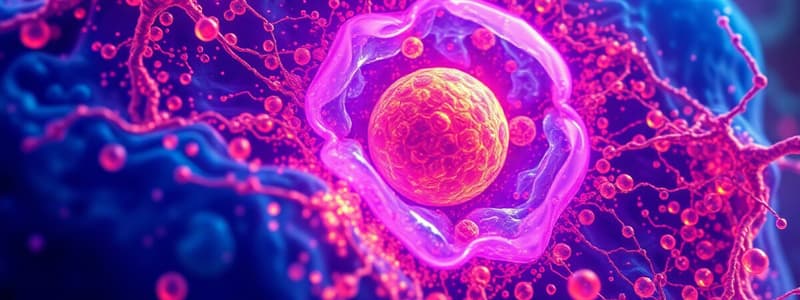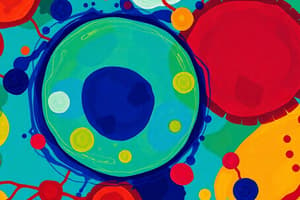Podcast
Questions and Answers
[Blank] (Hooke 1663) is the scientific study of cells.
[Blank] (Hooke 1663) is the scientific study of cells.
Cytology
The cell theory, developed by Schwann & Schleiden in the 1800s, states that all organisms are composed of cells and cell ______ which are the simplest structural and functional unit of life.
The cell theory, developed by Schwann & Schleiden in the 1800s, states that all organisms are composed of cells and cell ______ which are the simplest structural and functional unit of life.
products
According to the cell theory, an organism's structure and functions are due to activities of ______.
According to the cell theory, an organism's structure and functions are due to activities of ______.
cells
Cells come only from ______ cells, completing the cell theory.
Cells come only from ______ cells, completing the cell theory.
The improvements in microscopy allowed cell ______ visualization.
The improvements in microscopy allowed cell ______ visualization.
A ______ microscope revealed the plasma membrane, nucleus, and cytoplasm.
A ______ microscope revealed the plasma membrane, nucleus, and cytoplasm.
A transmission ______ microscope uses a beam of electrons rather than light to reveal detail.
A transmission ______ microscope uses a beam of electrons rather than light to reveal detail.
A ______ electron microscope produces dramatic 3-D images at high magnification and resolution, but only for surface features.
A ______ electron microscope produces dramatic 3-D images at high magnification and resolution, but only for surface features.
A cell is surrounded by a plasma (cell) ______.
A cell is surrounded by a plasma (cell) ______.
The plasma membrane defines cell boundaries and is made of proteins and ______.
The plasma membrane defines cell boundaries and is made of proteins and ______.
[Blank] is within the cell and contains organelles, cytoskeleton, inclusions, and cytosol.
[Blank] is within the cell and contains organelles, cytoskeleton, inclusions, and cytosol.
The fluid component of the cytoplasm is known as ______ or intracellular fluid (ICF).
The fluid component of the cytoplasm is known as ______ or intracellular fluid (ICF).
[Blank] are the internal structures of a cell that carry out specialized metabolic tasks.
[Blank] are the internal structures of a cell that carry out specialized metabolic tasks.
Membranous organelles are surrounded by ______.
Membranous organelles are surrounded by ______.
Examples of membranous organelles include the nucleus, mitochondria, lysosomes, peroxisomes, endoplasmic reticulum, and ______ complex.
Examples of membranous organelles include the nucleus, mitochondria, lysosomes, peroxisomes, endoplasmic reticulum, and ______ complex.
[Blank], centrosomes, centrioles, and basal bodies are examples of organelles without membranes.
[Blank], centrosomes, centrioles, and basal bodies are examples of organelles without membranes.
The advent of ______ microscopy enabled the visualization of cell ultrastructure, an advancement over traditional techniques.
The advent of ______ microscopy enabled the visualization of cell ultrastructure, an advancement over traditional techniques.
While light microscopy elucidates basic cell structures, the nuanced functions delegated to specific ______ within a cell remain obscured without higher-resolution techniques.
While light microscopy elucidates basic cell structures, the nuanced functions delegated to specific ______ within a cell remain obscured without higher-resolution techniques.
The conceptual leap from Hooke's initial observations of cells to the comprehensive cell theory articulated by Schwann and Schleiden hinged upon the refinement of ______ methodologies.
The conceptual leap from Hooke's initial observations of cells to the comprehensive cell theory articulated by Schwann and Schleiden hinged upon the refinement of ______ methodologies.
The dichotomy between membranous and non-membranous organelles reflects an evolutionary stratification wherein the former orchestrates complex biochemical reactions shielded by lipid bilayers, while the latter—exemplified by ______—facilitate fundamental processes like protein synthesis in direct contact with the cytosol.
The dichotomy between membranous and non-membranous organelles reflects an evolutionary stratification wherein the former orchestrates complex biochemical reactions shielded by lipid bilayers, while the latter—exemplified by ______—facilitate fundamental processes like protein synthesis in direct contact with the cytosol.
Flashcards
Cytology
Cytology
The scientific study of cells.
Cell Theory
Cell Theory
All organisms are composed of cells, an organism's structure and function are due to the activity of cells and cells come from preexisting cells.
Light Microscope
Light Microscope
Reveals plasma membrane, nucleus, and cytoplasm.
Transmission Electron Microscope
Transmission Electron Microscope
Signup and view all the flashcards
Scanning Electron Microscope
Scanning Electron Microscope
Signup and view all the flashcards
Plasma Membrane
Plasma Membrane
Signup and view all the flashcards
Cytoplasm
Cytoplasm
Signup and view all the flashcards
Organelles
Organelles
Signup and view all the flashcards
Membranous Organelles
Membranous Organelles
Signup and view all the flashcards
Non-membranous organelles
Non-membranous organelles
Signup and view all the flashcards
Study Notes
- Jairo Espinoza, MD is an Adjunct Instructor at Broward Science and Wellness, Broward College
Development of Cell Theory
- Cytology, which is the scientific study of cells, was discovered by Hooke in 1663
- The cell theory was developed by Schwann and Schleiden in the 1800s
- All organisms consist of cells and their products, with cells representing the most basic structural and functional unit of life
- An organism's structure and function are dictated by the activities of its cells
- Cells can only arise from pre-existing cells
Microscopy
- Advances in microscopy have enabled the visualization of cell ultrastructure
- A light microscope can show the plasma membrane, nucleus, and cytoplasm
- A transmission electron microscope employs electron beams instead of light, providing enhanced detail
- A scanning electron microscope generates high-resolution, high-magnification 3D images, but only for surface features
Basic Components of a Cell
- A cell is enclosed by a plasma membrane, which defines its boundaries and is composed of proteins and lipids
- Cytoplasm is located within the cell
- It contains organelles, cytoskeleton, inclusions (stored or foreign particles), and either cytosol or intracellular fluid (ICF)
Organelles
- Organelles are internal cellular structures performing specific metabolic tasks
- Membranous organelles are surrounded by membranes, including the nucleus, mitochondria, lysosomes, peroxisomes, endoplasmic reticulum, and Golgi complex
- Non-membranous organelles include ribosomes, centrosomes, centrioles, and basal bodies
Studying That Suits You
Use AI to generate personalized quizzes and flashcards to suit your learning preferences.




